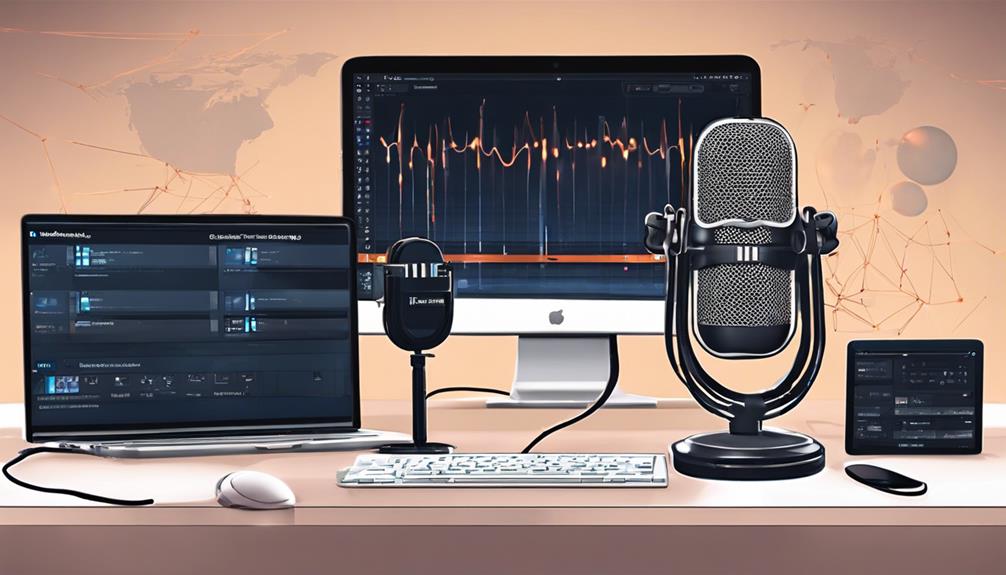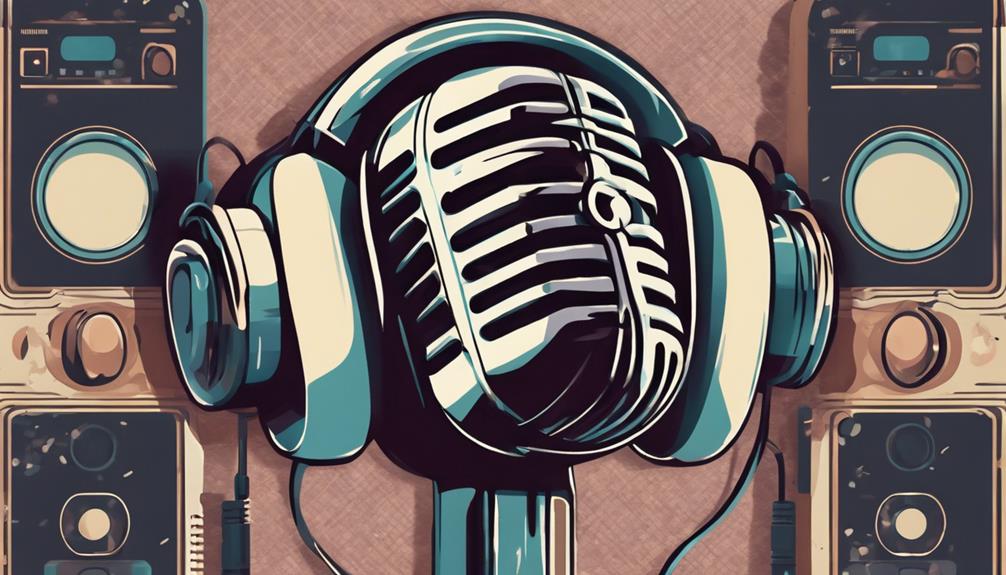Podcasting involves creating digital audio files that become episodes distributed through hosting platforms. These platforms facilitate on-demand listening via RSS feeds for easy subscription to get new content promptly. The process begins with recording equipment for high-quality audio and includes editing to refine the listening experience. Specific tools like Audacity help in this enhancement. Vital steps include uploading episodes to the hosting service, which then generates RSS feeds for subscribers. For a thorough understanding, exploring podcasting basics, creation processes, and hosting services can enhance podcasting knowledge further.
Key Takeaways
- Create audio episodes on specific topics or genres.
- Upload episodes to a podcast hosting platform.
- Distribute episodes to various podcast directories.
- Subscribers receive new episodes via RSS feeds.
- Engage with listeners for feedback and growth.
Podcasting Basics
Podcasting Basics involve the creation of digital audio files that users can download or stream on-demand. These audio files, known as episodes, make up a podcast show that users can listen to for entertainment, education, or information. Hosting platforms play a vital role in distributing podcasts, allowing listeners to access content easily. To keep up with new episodes, users can subscribe to podcasts using RSS feeds, ensuring they never miss a show.
Creating engaging podcast content involves recording high-quality audio that captivates the audience. Podcasters act as hosts, guiding listeners through each episode with their unique style and personality. It's crucial to focus on a specific theme or topic to attract a target audience interested in that content. As the popularity of podcasts continues to grow, more creators are exploring video podcasts to enhance visibility on platforms like YouTube.
Podcast Creation Process
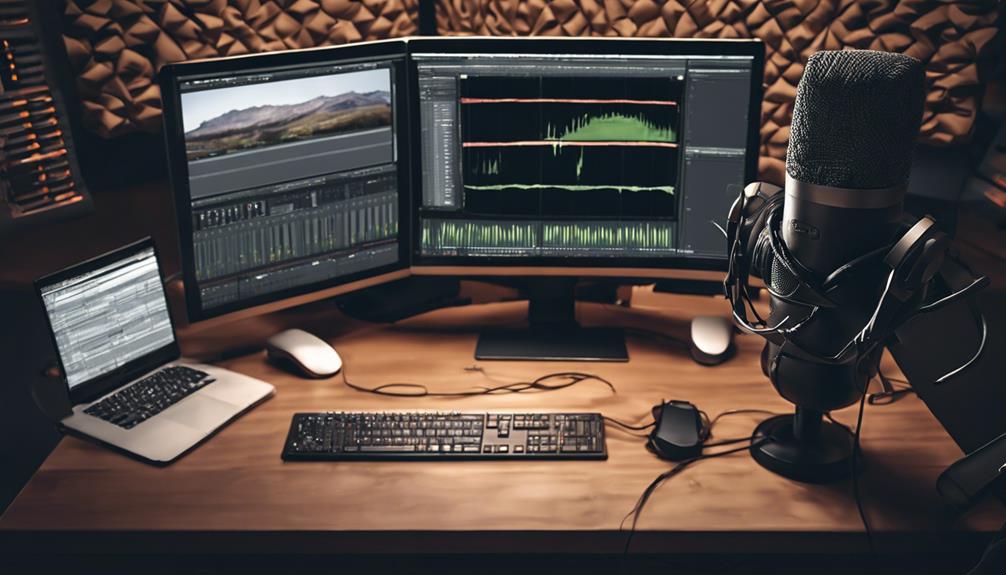
When creating a podcast, it involves recording audio content using specific equipment, editing the recordings for quality, and preparing them for distribution.
Once the audio is polished, podcasters upload their episodes to hosting services to generate RSS feeds, making it easier for subscribers to access the content.
This process includes recording equipment needs, editing and post-production tasks, and hosting and distribution strategies to guarantee a successful podcast launch.
Recording Equipment Needed
To guarantee high-quality audio recordings for your podcast, investing in a quality USB microphone is essential. While USB microphones offer convenience and plug-and-play simplicity, upgrading to XLR microphones can take sound quality to the next level.
Digital recorders provide flexibility in recording setups, allowing for on-the-go podcast production. Accessories like pop filters and microphone stands help create an ideal recording environment by reducing unwanted noise and ensuring microphone stability.
Beginners can benefit from researching equipment reviews to find the best podcasting gear for their needs. By carefully selecting the right recording equipment, podcasters can enhance their sound quality and streamline their production process, setting the stage for a successful podcasting journey.
Editing and Post-Production
In our podcast creation process, we enhance our audio content through meticulous editing and post-production techniques. Using advanced editing software like Audacity or Adobe Audition, we refine audio content, enhance quality, and insert flow enhancements to create a smooth listening experience for our audience.
Post-production tasks such as balancing audio levels guarantee that each podcast episode meets our high standards. By focusing on these details, we elevate the production value of our podcast, engaging listeners and fostering a loyal audience.
The efforts put into editing and post-production play a vital role in delivering a professional and engaging podcast that aligns with our brand's identity and keeps our audience coming back for more.
Hosting and Distribution
Moving on from the meticulous editing and post-production stage, our podcast journey now ventures into the domain of hosting and distribution, essential components of the podcast creation process.
When it comes to podcast hosting platforms, services like Buzzsprout and Podbean play an important role in storing and distributing digital audio files for podcasters. These platforms also generate the podcast RSS feed, which automatically updates subscribers with new episodes.
Additionally, podcast directories such as Apple Podcasts and Spotify serve as key distribution channels, allowing listeners to discover and access a wide range of podcasts easily. This process of uploading audio content, setting up distribution channels, and engaging with listeners forms an integral part of the podcast creation process.
Podcast Distribution Methods

Podcasts are distributed through RSS feeds, allowing subscribers to easily access new episodes. Hosting services like Buzzsprout and Podbean store podcast files and distribute them to various platforms.
Podcast directories such as Apple Podcasts and Spotify help listeners discover a wide range of podcasts.
Distribution Platforms
Among the key components of podcasting infrastructure are the various distribution platforms available to content creators and listeners alike.
- Apple Podcasts, Spotify, Google Podcasts, Stitcher, and Overcast are popular podcast distribution platforms where creators can upload episodes and submit their RSS feeds for easy access.
- Podcast directories play an important role in helping users discover new shows based on genres, topics, and recommendations.
- These distribution platforms offer customization options such as playlists, downloads, subscriptions, and notifications, enhancing the overall podcast listening experience.
The innovation in podcast distribution platforms has greatly contributed to the growth of the podcasting industry, making it easier for both creators and listeners to engage with a wide range of content seamlessly.
RSS Feeds
Utilizing RSS feeds is a vital aspect of podcast distribution methods, allowing podcasters to automatically share audio files with subscribers. When podcasters create an RSS feed for their podcast, it includes essential information about episodes such as titles, descriptions, and links to media files.
Subscribers utilize podcast apps to access these RSS feeds, enabling them to receive new episodes as soon as they're published. This seamless process guarantees that listeners stay updated with the latest content from their favorite podcasts without the need for manual intervention.
Podcast hosting platforms play an important role in generating and managing these RSS feeds, ensuring smooth distribution to subscribers through various podcast apps and directories.
Podcast Monetization Strategies
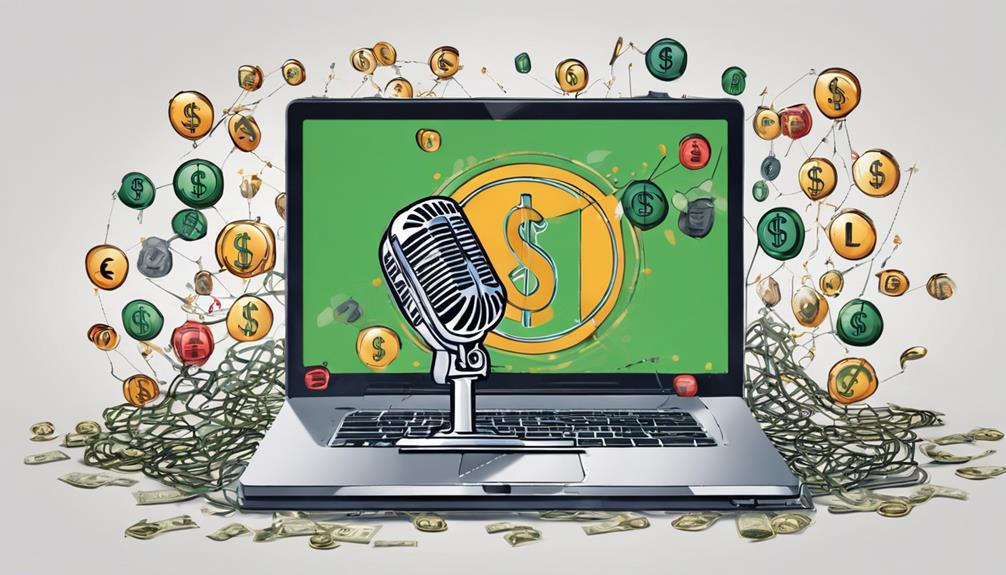
How can podcasters effectively generate revenue through various monetization strategies?
Podcast monetization strategies offer innovative ways for content creators to monetize their podcasts and cultivate a sustainable income. Here are three key methods:
- Sponsorships: Partnering with advertisers can be a lucrative way to monetize podcasts. Advertisers pay to have their products or services promoted on podcasts, providing podcasters with a steady stream of income.
- Affiliate Marketing: By engaging in affiliate marketing, podcasters can earn commissions for endorsing products or services. This strategy not only generates revenue but also allows podcasters to align with brands that resonate with their audience.
- Premium Content: Offering exclusive episodes, bonus material, or behind-the-scenes access to subscribers can create a revenue stream. By providing additional value to loyal listeners, podcasters can monetize their content while fostering a dedicated community.
Exploring these podcast monetization strategies can help content creators diversify their revenue streams and build a sustainable business model.
Podcast Equipment Essentials
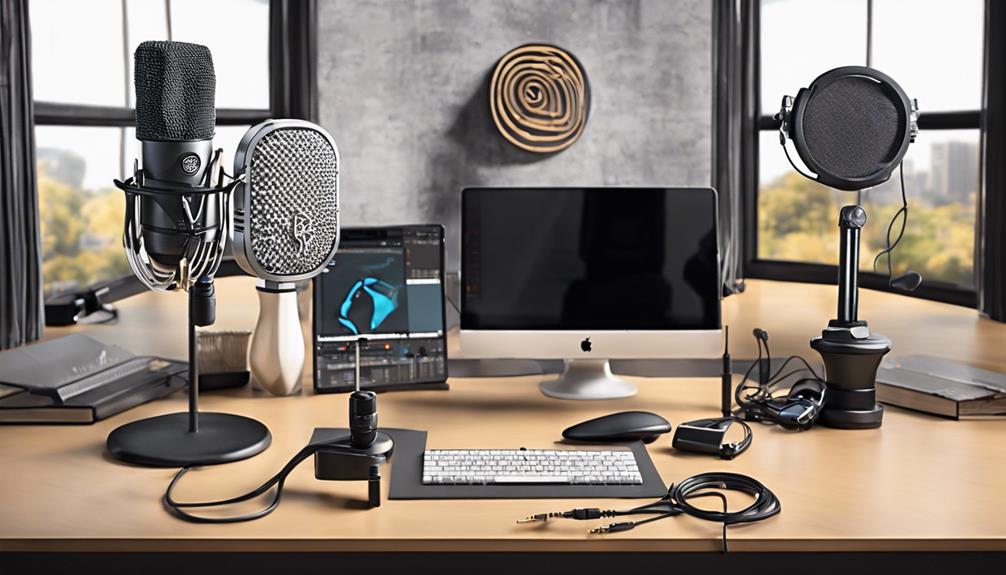
When setting up a podcast, investing in essential equipment like a quality USB microphone is essential for ensuring clear audio recording. USB microphones are user-friendly and provide good sound quality, making them ideal for beginners in podcast production. For advanced sound quality, XLR microphones are preferred among podcasters looking to enhance their audio recordings.
Digital recorders offer flexibility, allowing podcasters to record episodes on the go. Accessories like pop filters and mic stands can further improve audio recording quality by reducing background noise and ensuring the microphone is properly positioned. Researching equipment reviews and recommendations is important for beginners to make informed decisions about which podcasting equipment best suits their needs.
Podcast Hosting Services

Are you searching for a reliable platform to efficiently upload and distribute your podcast episodes? Podcast hosting services like Buzzsprout and Podbean offer solutions to help you reach a wider audience and manage your podcast effectively. Here are some key features of podcast hosting services:
- Distribute Content: These services allow you to upload audio files and distribute your content across various streaming platforms, making it easily accessible to listeners worldwide.
- Analytics Tracking: Hosting services provide valuable analytics tools to track listener engagement and download metrics. This data helps you understand your audience better and tailor your content to their preferences.
- Secure Storage and Management: With secure storage options, your podcast files are stored reliably, ensuring uninterrupted streaming and downloading. You can also efficiently manage your episodes, schedules, and audience interactions through these platforms, enhancing the overall podcasting experience.
Choose a podcast hosting service that aligns with your needs and goals to maximize the potential of your podcast.
Podcast Production Steps
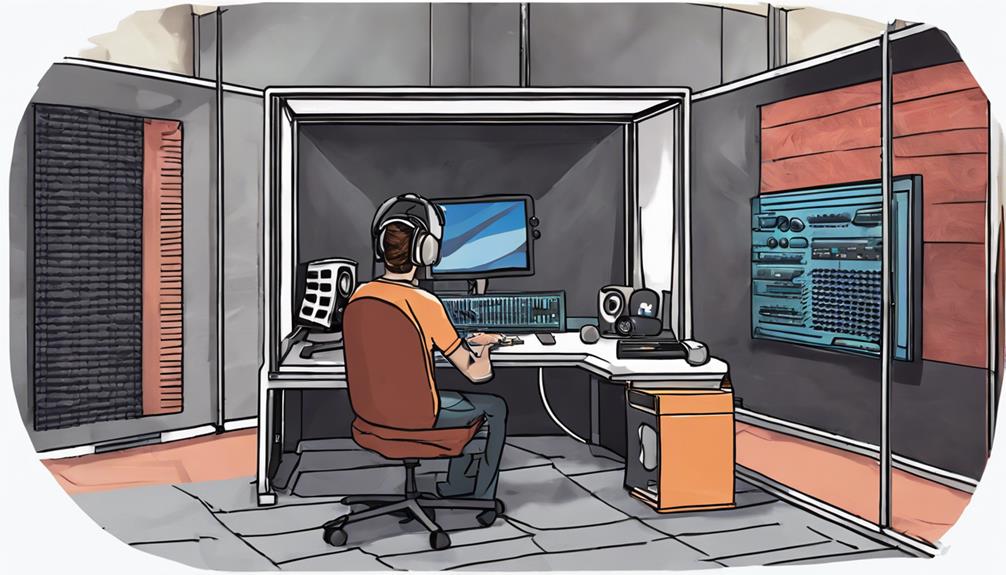
Exploring the intricate process of podcast production reveals the meticulous steps involved in creating engaging audio content for listeners worldwide. Podcast production encompasses recording audio, utilizing editing software to enhance quality, and saving the final product as an MP3 file. Podcasters rely on platforms like Audacity or Adobe Audition to refine their episodes, removing errors and incorporating music or sound effects to captivate their audience. Once production is complete, episodes are uploaded to a podcast hosting service for distribution to various platforms such as Apple Podcasts and Spotify. To make episodes more discoverable, podcasters add metadata like episode titles, descriptions, and tags. Moreover, promoting podcasts through social media sharing, email newsletters, and collaborations is essential in attracting a broader audience. By employing these production steps and promotion strategies, podcasters can effectively reach and engage with their target listeners.
| Podcast Production Steps | |
|---|---|
| Recording Audio | Editing Software |
| MP3 File | Podcast Hosting Service |
| Metadata | Episode Title |
| Social Media Promotion | Email Newsletters |
| Collaborations |
Podcast Promotion Techniques
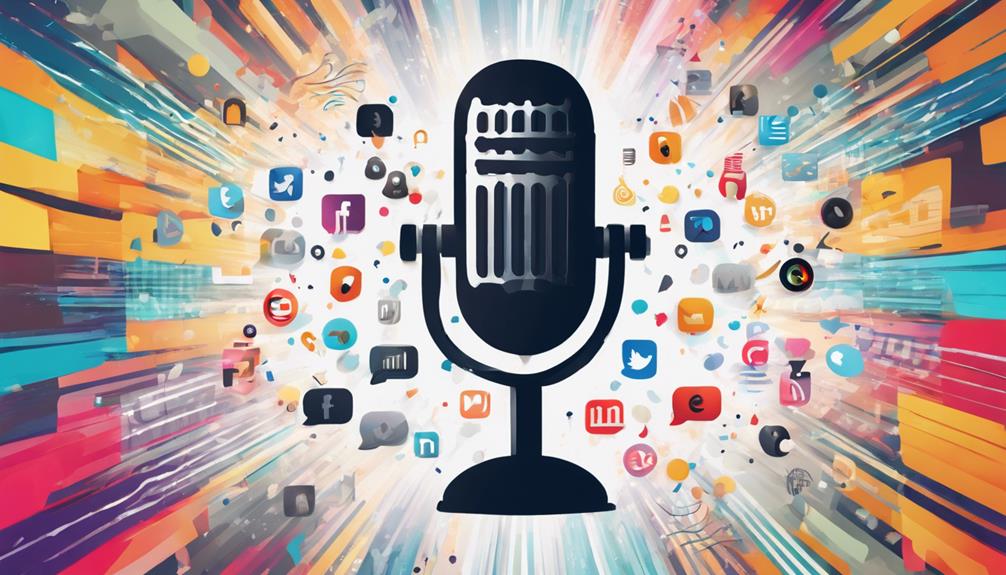
To effectively promote a podcast, utilizing social media platforms like Instagram, Twitter, and Facebook is essential for engaging with listeners and attracting a wider audience. When it comes to podcast promotion techniques, here are three innovative strategies worth exploring:
- Collaborate for Cross-Promotion: Partnering with other podcasters allows for cross-promotion opportunities, reaching new audiences, and increasing visibility in the podcasting community.
- Leverage Email Marketing: Engage with your subscribers through email marketing campaigns to notify them about upcoming episodes, special guests, or exclusive content, keeping them excited and involved.
- Implement SEO Strategies: Optimize your podcast titles, descriptions, and show notes to enhance search engine visibility and discoverability, making it easier for potential listeners to find your podcast online.
Frequently Asked Questions
How Do Podcasters Make Money?
We make money in various ways as podcasters. Sponsorships, advertising deals, listener donations, and affiliate marketing partnerships are common sources.
Additionally, we offer premium content, bonus episodes, live events, merchandise sales, and exclusive brand partnerships to bolster our revenue streams.
Diversifying income sources guarantees financial stability and growth as we connect with our audience and deliver valuable content they love.
What Is a Podcast and How Does It Work?
Podcasts are audio files that cover various topics, like news, education, and entertainment, distributed through platforms such as Apple Podcasts and Spotify. Listeners can easily access and stream episodes on devices like smartphones and computers.
Hosts create and publish content regularly, engaging with their audience through spoken episodes. This format allows for on-demand listening, offering a convenient way to stay informed or entertained on the go.
How Do You Start a Podcast for Beginners?
So, how do we start a podcast for beginners?
Well, first, choose a topic you love. Then, grab a USB mic and recording software for high-quality audio.
Next, sign up with a hosting platform like Buzzsprout. Make eye-catching cover art and catchy titles.
Spread the word on social media and directories. Engage with your audience for growth and feedback.
Happy podcasting, folks!
Do People Get Paid to Be on a Podcast?
Yes, people can get paid to be on a podcast. Compensation varies based on factors like expertise, popularity, and the podcast's budget. Payments range from flat fees to exposure and networking opportunities.
Negotiations or contracts often determine payment terms. It's common, especially for well-known guests or experts in specific fields, to receive payment for podcast appearances, reflecting the industry's diverse revenue models.
Conclusion
To sum up, podcasting is a powerful tool for sharing information and connecting with audiences worldwide.
Did you know that over 1.75 million podcasts are available online today, with the number growing every day?
By understanding the basics of podcasting, from creation to distribution and monetization, you can join the growing community of podcasters and share your voice with the world.
Explore the endless possibilities of podcasting and start creating your own unique content today!

